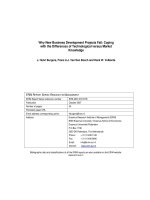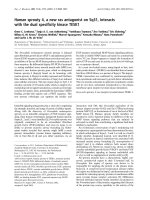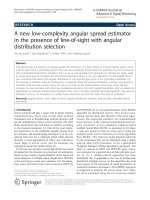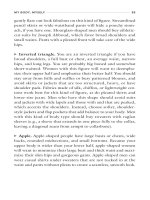Why New Business Development Projects Fail: Coping with the Differences of Technological versus Market Knowledge pot
Bạn đang xem bản rút gọn của tài liệu. Xem và tải ngay bản đầy đủ của tài liệu tại đây (208.91 KB, 43 trang )
Why New Business Development Projects Fail: Coping
with the Differences of Technological versus Market
Knowledge
J. Henri Burgers, Frans A.J. Van Den Bosch and Henk W. Volberda
ERIM REPORT SERIES RESEARCH IN MANAGEMENT
ERIM Report Series reference number ERS-2007-072-STR
Publication October 2007
Number of pages 40
Persistent paper URL
Email address corresponding author
Address Erasmus Research Institute of Management (ERIM)
RSM Erasmus University / Erasmus School of Economics
Erasmus Universiteit Rotterdam
P.O.Box 1738
3000 DR Rotterdam, The Netherlands
Phone: + 31 10 408 1182
Fax: + 31 10 408 9640
Email:
Internet:
www.erim.eur.nl
Bibliographic data and classifications of all the ERIM reports are also available on the ERIM website:
www.erim.eur.nl
ERASMUS RESEARCH INSTITUTE OF MANAGEMENT
REPORT SERIES
RESEARCH IN MANAGEMENT
ABSTRACT AND KEYWORDS
Abstract
Managing through projects has become important for generating new knowledge to cope with
technological and market discontinuities. This paper examines how the fit between the creation
of technological and market knowledge and important project management characteristics, i.e.
project autonomy and completion criteria, influences the success of new business development
(NBD) projects. In-depth longitudinal case research on NBD-projects commercialised during the
period 1993-2003 in the consumer electronics industry highlights that project management
characteristics focusing only on the creation of technological knowledge contributed to the failure
of those NBD-projects that required new market knowledge as well. The findings indicate that
senior management support and engaging in an alliance with partners possessing
complementary market knowledge can offset this misalignment of the organisation of NBD-
projects.
Free Keywords
project management, new business development, exploitation-exploration, knowledge, new
product development, strategic alliances, sales force
Availability
The ERIM Report Series is distributed through the following platforms:
Academic Repository at Erasmus University (DEAR),
DEAR ERIM Series Portal
Social Science Research Network (SSRN), SSRN ERIM Series Webpage
Research Papers in Economics (REPEC), REPEC ERIM Series Webpage
Classifications
The electronic versions of the papers in the ERIM report Series contain bibliographic metadata
by the following classification systems:
Library of Congress Classification, (LCC)
LCC Webpage
Journal of Economic Literature, (JEL), JEL Webpage
ACM Computing Classification System CCS Webpage
Inspec Classification scheme (ICS), ICS Webpage
1
Why New Business Development Projects Fail: Coping with the Differences of
Technological versus Market Knowledge
*
(Final Version September 25, 2007)
J. Henri Burgers
Frans A.J. Van Den Bosch
Henk W. Volberda
RSM Erasmus University
Department of Strategy and Business Environment
Erasmus University Rotterdam
P.O. Box 1738, 3000 DR Rotterdam, the Netherlands
Phone: +31.10.408.1126
Fax: + 31.10.408.9013
E-mail: ; ;
www.strategyaterasmus.nl
Paper accepted for publication in Long Range Planning, vol 40, 6
(2007)
Special issue “Managing through Projects in Knowledge-Based
Environments”
* We gratefully acknowledge the participation of ELECTRA for our case research, and their
management’s constructive comments on previous drafts of our case analysis. We also express
our gratitude to the editors of the special issue and LRP, the three anonymous reviewers, Paul
Vlaar, Pieter-Jan Bezemer, participants of a workshop held at Cass Business School, London,
March 27, 2006, and of a seminar on NBD-projects organised by the Dutch Association of
Business Development Project Managers at the RSM Erasmus University, 25 April 2006 for
their suggestions on improving the paper.
2
J. Henri Burgers is a research associate at the Department of Strategic Management and Business
Environment of the RSM Erasmus University and conducts research in the area of new business
development projects and corporate entrepreneurship. He has published in a book and a Dutch
academic journal. For further information: www.rsm.nl/hburgers
Frans A.J. Van Den Bosch is a full professor of Management Interfaces between Organisations
and Business Environment at the Department of Strategic Management and Business
Environment of the RSM Erasmus University, and is chairman of the Programme Board of the
Erasmus Research Institute of Management. He has published several books and articles in
journals including Academy of Management Journal, Corporate Governance, Journal of
Management Studies, Long Range Planning, Management Science, Organization Science, and
Organization Studies. He is an editorial board member of among others Journal of Management
Studies and Long Range Planning. For further information: www.rsm.nl/fvandenbosch
Henk W. Volberda is full professor of Strategic Management and Business Policy, chair of the
Department of Strategic Management and Business Environment, and vice-dean at the RSM
Erasmus University. He has published widely in journals such as Academy of Management
Journal, Journal of Management Studies, Long Range Planning, Management Science,
Organization Science, and Organization Studies. He is senior editor of LRP and JIBS, and
member of the editorial board of Journal of Management Studies, Organization Science and Org.
Studies. His research on organisational flexibility and strategic change received several awards,
including the prestigious Igor Ansoff Strategic Management Award 1993. For further
information: www.rsm.nl/hvolberda
3
Why New Business Development Projects Fail? Coping with the Differences of
Technological versus Market Knowledge
Abstract
Managing through projects has become important for generating new knowledge to cope with
technological and market discontinuities. This paper examines how the fit between the creation
of technological and market knowledge and important project management characteristics, i.e.
project autonomy and completion criteria, influences the success of new business development
(NBD) projects. In-depth longitudinal case research on NBD-projects commercialised during the
period 1993-2003 in the consumer electronics industry highlights that project management
characteristics focusing only on the creation of technological knowledge contributed to the
failure of those NBD-projects that required new market knowledge as well. The findings indicate
that senior management support and engaging in an alliance with partners possessing
complementary market knowledge can offset this misalignment of the organisation of NBD-
projects.
Keywords: project management; new business development; exploitation-exploration;
knowledge; new product development; strategic alliances; sales force
4
Introduction
In today’s fast-paced, knowledge-based environments competitive advantages erode at an
ever-increasing rate. Companies need to continuously develop new business opportunities to
tackle technological and market discontinuities. However, the managerial and organisational
structures of most firms are primarily catered towards exploitation activities like refining
products and processes. These structures do not support the requirements for exploring new
business opportunities.
1
Managers therefore increasingly use projects to create new businesses.
A key aspect of New Business Development (NBD-) projects is the management of
knowledge.
2
Research has shown that project success is enhanced if project management
characteristics are aligned with the project’s activity.
3
Previous studies have made a distinction
between projects that develop exploitative or incremental innovations versus exploratory or
radical innovations.
4
Radical innovations require both new technological knowledge and new
market knowledge, while incremental innovations use and leverage existing technological and
market knowledge.
5
However, Danneels suggested that an important distinction should be made between
technological and market knowledge, as it has been argued that NBD-projects might create one
type of knowledge and leverage another type of knowledge.
6
Technological knowledge refers to
knowledge associated with products, technologies and/ or processes. Market knowledge refers to
knowledge associated with targeting customer sets, entering markets, distribution channels,
marketing approaches, and business models.
7
New business development is the process of
linking the technological and market knowledge together.
8
Although the two types of knowledge
are intertwined, their project management requirements and implications for the wider
organisational context could differ (see Exhibit 1).
9
5
Insert Exhibit 1 here
The distinction between the newness of technological and market knowledge is important
for at least two reasons. First, both types of knowledge reside in different departments (R&D
versus marketing/ sales). This might have consequences for the autonomy of projects in terms of
leveraging knowledge. Second, the timing of development differs for both types of knowledge.
Knowledge creation involves learning-by-doing.
10
Yet, experimenting with market approaches
and distribution channels will take place after market introduction, while practicing with
products and technologies is done before market introduction. This suggests that project
completion criteria might be different for creating technological versus market knowledge.
Given the limited insight in the consequences of technological and market knowledge for
NBD-projects, we will address the following research question: How does creation of
technological and market knowledge influence project management characteristics of NBD-
projects? By doing so, we address the role of projects as focal points of knowledge creation and
integration and provide insights into the conditions for the successful management of NBD-
projects. We focus our longitudinal research on new business development projects in a large
incumbent firm in the consumer electronics industry.
Our findings highlight that technological and market knowledge should have a different
effect on project autonomy. By doing so, we extend previous research that has focused on the
distinction between exploitative versus exploratory innovations and its effect on project
6
autonomy.
11
Second, building upon Danneels’ work, we show the timing and duration of
development differs between market and technological knowledge.
12
Our findings indicate that
the creation of market knowledge is likely to continue after market introduction, i.e. during the
commercialisation phase. Extending the managing-through-projects approach to the
commercialisation phase enhances the success of NBD-projects requiring new market
knowledge. Third, our research shows that two strategies can be applied to off-set deficiencies in
project management. Top management support can be used to prolong the project approach and
to shield the project from organisational pressures to exploit. Our findings also indicate that
strategic alliances with partners possessing complementary market knowledge significantly
shorten the time to acquire new market knowledge for NBD-projects.
Literature review
Innovation is not only the creation of new knowledge, but also the recombination with
existing knowledge.
13
The processes of creating new knowledge versus leveraging existing
knowledge are referred to as exploration and exploitation. Exploration is the act of creating
knowledge that is new to the firm through activities such as experimentation, innovation, search
and variation. Exploitation is the act of using knowledge existing in the firm and is associated
with implementation, efficiency, production and refinement.
14
NBD-projects call for both the
exploration and the exploitation of knowledge.
15
Exploration and exploitation require, however,
different styles of management and organisational arrangements.
16
Several studies have been investigating how to manage the creation and transferring of
knowledge in the context of new business development.
17
Yet, these studies did not take into
account the effect the type of knowledge has on managing NBD-projects, even though it has
7
been argued that technological and market knowledge have different outcomes for
organisations.
18
The benefits of, among others, cross-functional teams, project autonomy, and
stage-gated development processes for the successful management of projects are well
established.
19
This paper explicitly focuses the relationship between project management
characteristics and technological and market knowledge. Success rates of NBD-projects are
enhanced if project autonomy is aligned with the degree of exploration of projects.
20
This
suggests connecting project autonomy with the degree of exploration of technological and
market knowledge. Studies have also shown that exploration and project management practices
change over the project’s life-cycle.
21
This suggests linking project completion criteria to the
phase in which exploration of technological and market knowledge occurs, as a prime objective
of NBD-projects is the creation of new knowledge.
Degree of exploration of technological and market knowledge and project autonomy
The degree of project autonomy influences to what extent the exploration and the
exploitation of knowledge is enhanced. The higher the project’s autonomy, the more precedence
the project takes over various functional areas and the development of its knowledge base.
22
A
high degree of project autonomy stimulates the exploration of knowledge, as it shields the
project from organisational inertia and knowledge bases.
23
At the same time, higher degrees of
project autonomy make learning and transferring knowledge between the project and the
organisation more difficult, because of the relative distance between the project and
organisational units.
24
Providing low degrees of autonomy to an NBD-project limits the ability to
explore new knowledge, but enhances the possibility to leverage existing knowledge and
resources from the parent organisation.
25
Autonomy could, inter alia, be increased by using
8
heavyweight leaders, by placing a project in physically distinct location, or by increasing the
reporting level.
26
Figure 1 depicts a conceptual framework of four idealised types of projects linking the
degree of technological and market knowledge newness to project autonomy. Projects requiring
new technological and market knowledge (see Figure 1, quadrant 1) benefit the most from
autonomy, as separating a project from the organisational context facilitates learning within the
project.
27
A typical structure for such radically new projects would be some sort of venture
unit.
28
Insert Figure 1 here
Product improvement projects that exploit both existing technological and existing
market knowledge benefit from staying close to the mainstream of the organisation to maximise
the potential for leveraging knowledge already present within the firm (see Figure 1, quadrant 4).
For these projects a functional or lightweight project type is preferred, which receives very little
autonomy.
29
Project members in this type of project divide their time between ongoing activities
in their functional department and the project. As such, these employees are in the best position
to leverage relevant knowledge and resources from their functional departments. Several authors
argue that NBD-project success is significantly enhanced if projects make use of the firm’s
existing sales force and distribution channels.
30
9
Projects exploring technological knowledge and exploiting market knowledge require a
medium degree of autonomy (see Figure 1, quadrant 2). These projects need autonomy for the
development of technological knowledge,
31
but need lower degrees of autonomy to exploit the
available market knowledge. We suggest, therefore, an intermediate solution with medium
degrees of autonomy for the project, which leaves room for both exploitation and exploration.
In a similar vein, projects needing exploration of market knowledge and exploitation of
technological knowledge would benefit most from a medium degree of autonomy (see Figure 1,
quadrant 3). Too close cooperation with marketing and sales might constrain the project’s ability
to explore market knowledge, and have a negatively impact on project performance.
32
This
suggests that the NBD-project needing exploration of market knowledge should receive a certain
degree of autonomy from sales organisations.
Besides exploring new knowledge internally, NBD-projects could also use strategic
alliances to develop the missing knowledge and capabilities. Previous research has shown that
partnerships with complementary resources and capabilities increase chances for success and
competitive advantage.
33
Using a partnership could speed up the development process and
significantly reduce investment costs.
34
Furthermore, it could also solve the potential conflict
between requirements of technological versus market knowledge in NBD-projects, as partners
could be responsible for one type of knowledge, while the project is focusing on the other type of
knowledge.
Phase in the NBD-process in which knowledge creation occurs and project completion criteria
Projects are temporary structures created to achieve a certain goal.
35
This suggests
defining clear project completion criteria. NBD-projects have the objective to explore new
10
products/ technologies, and/ or explore new markets, for the firm.
36
Project completion criteria
should, therefore, be aligned with the process of the exploration of technological and market
knowledge. Scholars have previously argued that NBD-projects end when a newly developed
product is introduced on the market.
37
This view limits the exploration of both technological and
market knowledge to the development phase preceding market introduction. We argue, however,
the exploration of technological and market knowledge end at different points in time.
Following Thornhill and Amit, we identify three phases in the process of new business
development (see Figure 2).
38
The development phase, ranging from the conception of ideas to
the introduction of developed products or services on the market. When products are introduced
on the market, the project enters the commercialisation phase, running from market introduction
until profitability is achieved (i.e. when cumulative profits surpass investment costs).
39
The final
phase is the business phase, when the project has become a business and is self-sustainable.
Insert Figure 2 here
The exploration of technological knowledge is mainly confined to the development
phase, with exploratory technological activities such as prototype and product development, and
building the (trial) production line. Before the product is approved for market introduction, the
end result of the technological development trajectory in terms of a working product and process
are usually tested on aspects such as durability and quality.
40
At the moment of market
introduction the product and production line are technically complete, requiring little additional
11
development of technological knowledge. The subsequent commercialisation phase calls for
exploitation of technological knowledge in order to increase the efficiency of the production
process and to refine the product. Hence, projects needing only the exploration of technological
knowledge should be completed after the development phase ending at market introduction (see
Figure 1, quadrant 2).
41
The exploration of market knowledge also starts during the development phase with
activities such as gaining knowledge about customer preferences and how to reach and target
potential customers (see Figure 2). Yet, exploration requires learning-by-doing, which for market
knowledge can to some extent only be learned during the commercialisation phase when
products are actually sold. This is a prime difference with technological knowledge creation in
which case one can experiment before products are actually sold on the market. The exploration
of market knowledge continues during the commercialisation phase, when for example concepts
are tested in the marketplace and distribution channels are developed. Based also on customer
feedback the market approach might be frequently changed during this phase.
42
NBD-projects
requiring new market knowledge should, therefore, only be completed at the end of the
commercialisation phase (see Figure 1, quadrants 1 and 3). At the end of this phase, the project
has become self-sustainable and does not need protection of top management or a set of special
criteria to further explore market knowledge. Concluding, the different phases in which
exploration of technological and market knowledge occurs (see Figure 2) suggests project
completion criteria for NBD-projects should be contingent upon the phase in which exploration
of technological and market knowledge takes place (see Figure 1).
12
Methods
The research reported here is based on an in-depth, longitudinal case study of new
business development projects at the DOMUS division of ELECTRA
i
, a major manufacturer of
consumer electronics. By selecting projects within a single division, we were able to reduce
potential confounding effects of the industry and the firm. This allowed us to best observe our
phenomena of interest, namely how the creation of technological and market knowledge and
project management practices influence the success of NBD-projects. To observe the changes in
organisational behaviour over time and to gain deeper understanding of the role of technological
and market knowledge creation in managing NBD-projects, we choose qualitative methods
instead of quantitative methods. The selected method increases the validity of our study, but at
the same time we acknowledge that we might loose possible generalisation to other industry
contexts.
The projects were selected based on the exploration of technological and market
knowledge (see Figure 3). All projects needed to have reached the commercialisation phase. To
measure the degree of exploration we first asked respondents to what extent the product/
technologies and markets were existing to the firm, new-to-the-firm, -industry, or -world.
Second, we asked them to explain what aspects where new, because something that is new to the
firm does not necessarily involve much exploration. For example, a firm can enter a new market
segment, but might use existing distribution channels and market approaches. Third, we
investigated company documents to look for statements on actual explorative behaviour. For
example, if minutes of meetings stated that the project team was developing medical knowledge
to sell their products through pharmacies as opposed to electronic retail stores, this would be
classified as exploration of market knowledge (see also Table 1). Using multiple sources of
i
Due to confidentiality agreements, we changed the name of the company.
13
evidence allowed us to develop a more fine-grained measure of the degree of exploration needed
than would be possible through survey research.
We used several rounds of data collection and a variety of internal company documents
like minutes of meetings and business plans, and external documents to analyse the projects.
Additionally, we interviewed several key project members, division executives, R&D directors,
and sales managers for the projects to triangulate the findings with different sources. Appendix 1
provides more detail on our research methods.
Insert Figure 3 here
Research setting
ELECTRA is a large multinational company that consists of several relatively
autonomous product divisions. Besides the product divisions, national and regional sales
organisations were part of the company. Because many of DOMUS’ products are sold through
the same retail stores, a single sales person of DOMUS offers the whole range of DOMUS’
products to a retail store instead of having different sales persons for each product line.
At the time of investigation, DOMUS consisted of a business group focusing on
household products and one focusing on personal care products. The business group of
household products had a diverse product portfolio, mostly in increasingly saturated markets.
Market growth had slowed down to around 2-3 percent and there was an increasing trend
towards commoditisation. Sales growth was mainly achieved through market share battles, but
14
management recognised opportunities for entering new markets and for radically redefining
existing product/market propositions. The business group of personal care products consisted of
a rather narrow, but highly profitable product portfolio that was also confronted with decreasing
sales growth. Yet, the opportunities for boosting growth were markedly different, as growth
opportunities were primarily in addressing new product categories.
DOMUS consisted of several business units that each contained a few business lines,
which consisted of one or more product lines. Units were defined based on relatedness of product
(categories). The business units were responsible for NBD-activities. The NBD-project managers
reported to a business line manager within these business units. NBD-projects within DOMUS
were cross-functional, and included both engineers as well as marketers. DOMUS used
heavyweight projects for the NBD-projects we investigated, but with relatively junior managers
leading the projects. The engineers and marketeers were assigned fulltime to a project, and had
clear responsibilities toward the project manager, although they formally reported to their
functional units. The projects were organised and the development activities executed according
to a standardised approach that was described in a manual. A senior project manager of Skin
pointed out:
“…we followed a very strict process, which was actually a best-in-class process with all the stages,
gates, and milestones, but this was very much driven from the [technological] development side. On the marketing-
side it was very loose.”
Case study findings
We investigated eight NBD-projects within DOMUS. These projects were executed
during the period 1993-2003. Table 1 presents an overview of the investigated projects. Project
Drink developed a segment of an existing market, while others targeted a market completely new
for ELECTRA (projects Health and Skin), or focused on markets that were geographically
15
relatively new for ELECTRA (project Cook). Several projects (Drink, Oral, and Health) made
use of an alliance to build the new business. All projects fitted within the defined strategy of
DOMUS to manufacture mass electronic consumer goods for household or personal care use.
The projects in our sample provided significant revenues. Projects Hair and Air achieved over 30
million euros in annual turnover two years after market introduction, while project Drink has
sold millions of products in the first four years after market introduction. Projects Fem and Oral
have grown into businesses with annual sales well exceeding 100 million euros.
Insert Table 1 here
Degree of exploration of technological and market knowledge and project autonomy
In the case of the exploration of technological knowledge, previous research suggests a
heavyweight project-type is preferred.
43
Projects Fem and Hair grew into successful businesses
by adopting this structure. All investigated projects and businesses within DOMUS were in the
area of consumer electronics, suggesting relatively similar technological bases. This allowed
project teams to build on the capabilities of the engineers to create electronic products for
household use. The heavyweight structure provided projects with sufficient autonomy to create
new knowledge, while the project was still sufficiently integrated with other units to leverage
existing capabilities. The projects used employees from the R&D departments which further
facilitated the access to relevant knowledge and capabilities. Project Cook received more
autonomy than the other investigated projects. Instead of the standard approach of developing the
16
project at one of the operational business units, project Cook was situated in Asia. This limited
project Cook’s access to organisational knowledge and support, as the project was far away from
the company’s business units in Europe. As a result, the project had to develop many of the
competencies regarding manufacturing and testing the product itself. It did not draw on
employees from R&D departments, but hired new personnel. This resulted in long lead times and
poor initial product quality, which had adverse effects on the project’s performance.
Although the projects’ degrees of autonomy were adequate for the exploration of
technological knowledge, it did create problems for the exploration of market knowledge. Most
projects operated autonomously from the sales organisations. A sales manager pointed out: “The
BU sometimes developed things without full commitment and involvement of the sales organisations. There was a
somewhat isolated attitude, in the sense of wait until it is finished and we’ll show you. Here and there were some
walls in the organisation over which something was thrown from time to time.”
The task of NBD-projects
was to explore what should be done regarding the market, in terms of new distribution channels
and new marketing approaches. The sales organisations were responsible for exploitation in the
sense that they had to sell the products through the new distribution channels etc. The sales
representatives had, however, neither the time nor the resources to learn how to sell the
developed product through new distribution channels. The projects received time and resources
to search new knowledge, but sales employees did not receive time and resources to learn and
practice. In an interview a business manager of Oral pointed out:
“An important market for Oral was
country X. The average age of the sales employees was around 50 and they had been selling kitchen appliances for
25-30 years. Could we ask of these sales employees to suddenly have a talk with specialists about inter-dental
cleaning?”
This proved to be too difficult and currently project Oral still has its own sales force
and is managed autonomously from other business units.
17
Several projects tried to compensate for their lack of market knowledge by engaging in
an alliance with a partner possessing the required market knowledge (see Table 1). The business
manager of Project Oral continued: “That’s one of the reasons we established the alliance and did the
acquisition. It proved too difficult to build up our own competences and network regarding professional
endorsement by medical specialists.”
The alliance partner did have the competences and network.
There was, however, some overlap on the technological side, which led to disputes between both
parties on how certain parts should be constructed and who should develop it. Combined with the
somewhat diverging interests and the lack of alliance experience of both companies, this led to
disbanding the alliance. Project Drink’s alliance, however, was a major success. Project Drink
used a new business model in which revenues from so called consumables were the main profit
drivers instead of the core product (recall Polaroid’s razor/blade strategy discussed in the theory
section in which camera prices were kept low to stimulate demand, while the profit was made on
the film, i.e. the consumable). But project Drink had limited experience with selling and
marketing these consumables. The partner did have a background in these consumables and took
care of developing and selling the consumable, while project Drink handled the development and
selling of the core product. This complementarity made them ideal partners. Establishing the
alliance was, however, a slow and painstaking negotiation process, because of the limited
experience of DOMUS with such alliances. The success of this alliance contributed to the
establishment of a corporate alliance office to capture and leverage knowledge on establishing
alliances.
Concluding, the autonomy of the project influenced to what extent projects were able to
explore technological and market knowledge, and benefit from knowledge already existing in the
firm. As suggested by the case study, a heavyweight project placed within the operational
business units provides sufficient autonomy to develop new products, but is still able to leverage
18
relevant technological knowledge and capabilities. If a project receives more autonomy (e.g.
Project Cook) it needed more time to develop technological knowledge, as it could not draw on
available knowledge, skills, and personnel. Regarding market knowledge, however, the
investigated projects were too autonomous from the relevant sales organisations. By not being
involved in the project, the sales organisations did not receive the time and resources to develop
and experiment with novel market approaches. The case study indicates that strategic alliances
are useful to decrease the time it takes to acquire new market knowledge and the time to achieve
profitability. Projects Drink and Oral demonstrate the impact of such alliances, as they became
major successes, while other projects exploring market knowledge (Air, Skin, and Cook)
continued their struggle to find the right approach towards the market.
Phase in the NBD-process in which exploration occurs
A major difference between technological and market knowledge is when the exploration
takes place. In our case study, the exploration of technological knowledge took place before
market introduction. The product development ended with exposing the products to durability
tests, which were performed before introduction on the market. Production processes were
constructed and many trial runs were done before the project was given the green light to start
manufacturing for first sales. Most projects benefited from testing facilities and capabilities the
company already possessed. For projects Oral, Cook and Health existing tests were not
applicable. A project manager of project Oral stated:
“A lot of our standard tests were designed for a
kitchen environment. Our product was however used in a bathroom, in which the atmosphere is warmer and moister.
We had to learn how to test for this.”
Project Cook faced similar problems, as it had to build up testing
competencies in Asia. Despite difficulties with testing the product, these projects continued with
19
market introduction. The pressure to launch quickly led projects Cook, Health and Oral to
prematurely introduce the products on the market, resulting in high recall rates for their products.
The exploration of market knowledge also started during the development phase (see
Figure 2). A project manager of project Skin commented on the market research: “It is a new
business, how do you know how many we can sell? You can improve your guessing with more and better customer
research and knowing how to understand the numbers. The problem was that we did not know how to interpret the
numbers we got back, as we had no data to compare it to.”
This lack of understanding of the market led to
flaws in the project’s assumptions, product positioning and business model, which came to the
surface during the commercialisation phase. In an interview, the project manager of Skin stated:
“Two of the major reasons that brought Skin down were marketing and distribution. We found out that the average
time it took a consumer to decide to purchase our product was three months, while for the average product DOMUS
sold it is more in the area of two days. During that three month period you have to get your message out and
convince potential consumers, as they will ask everybody from their friends to their doctor what they think of the
product.”
A former business manager of Oral also stressed the exploration of market knowledge
still taking place: “The traditional way of DOMUS for a market introduction campaign was to execute just one
brief mass marketing campaign and that is it. We had to learn that we regularly had to contact medical specialists to
achieve professional endorsement.”
From the case analysis it appears there was hardly any time left to create the required
market knowledge once products had been introduced on the market, due to the imposed project
completion criteria. During the commercialisation phase projects were managed according to
criteria similar to managing existing businesses within DOMUS. First, projects had to use a
mass-introduction strategy in multiple countries, which a project manager labelled the “do-it-right-
the-first-time approach”.
A second criterion was that NBD-projects had to achieve profitability
within 2 years, i.e. investment costs should be earned back within this 2-year period. A third
criterion stated that projects needed to use their own revenues if they wanted to make additional
20
investments in exploration once products had been introduced on the market. In other words,
projects were considered to be completed at the moment of market introduction. During the
commercialisation phase these activities were viewed as emerging businesses, which were
granted two years to achieve profitability levels comparable to other businesses. A project
manager of Cook pointed out:
“we performed relatively well on the milestones in the development phase, but
that is one of the strengths of DOMUS. The bigger project Cook, however, was not handled in a project-like way.
That was more the running of a daily business.”
Of the eight investigated projects, Fem and Hair were the only two projects that did not
need significant exploration of market knowledge (see Table 1 and Figure 3). These projects
became instant successes, as they benefited from leveraging existing market knowledge bases.
The criteria to view the project as completed at market introduction were aligned with the
exploration of technological knowledge, which took place before market introduction.
Out of the six projects that required exploration of market knowledge, only two projects
became a success. The four failing projects were seriously constrained by the before-mentioned
business criteria imposed on them during the commercialisation phase. Project Air, for example,
used a mass-introduction strategy on multiple markets. After market introduction, the project
experienced several problems with the business model, marketing approach and distribution
channels. As a consequence, demand was far lower than expected and 80% of the production
capacity remained unused. The project either needed significant investments to turn the tide or
needed to write off the initial investments and continue on a smaller scale. Yet, the criteria
imposed by top management did not allow these options, as projects only got two years to
become profitable and were not entitled to financial support.
The two successful projects (Drink and Oral) managed to offset these project completion
criteria that were not aligned with exploration during the commercialisation phase. Project Drink
21
used an alliance for the exploration of market knowledge, i.e. the business model and market,
and more importantly used a single test market to further explore if the developed product
propositions and marketing campaigns are effective. In an interview an R&D manager pointed
out: “What worked very well was using a single test market. It created success, which worked positively towards
other markets. The idea was to keep it small, learn and use the experience gained in other markets. Once you have
success it is easier to convince management to invest additional resources for launch in other countries.”
The
marketing manager of project Drink explained the exploration of market knowledge: “through
project Drink we learned how to do this. Just testing it in the market and learn about optimal product positioning,
marketing strategies and then executing it on a larger scale.”
The number of products sold during the first
year was three times higher than the most positive scenario, which shows the advantage of a
project approach over a business approach in the case of exploration of market knowledge during
the commercialisation phase.
Project Oral became a success after almost 10 years of experimentation, learning, and
development, resulting in significant investments and losses. The project completion criteria that
were established for NBD-projects that reached the commercialisation phase (i.e. becoming
profitable in two years) were, however, overruled by the responsible business manager. In an
interview, a former project manager of Projects Air and Cook commented: “One of the most
important things is creating the right environment and support for the new business. In personal care for example
they committed themselves if they spotted an important opportunity. A good example is project Oral. The first five
years were basically a disaster. Everybody in the organisation yelled that we should stop, as our product quality was
inferior compared to the competition. But there was one manager who said these comments were fine and all that,
but the project would continue.”
The champion had sufficient authority and resources at his disposal to
actually allow the project to continue. Other projects needing additional time to develop the
markets also had champions, but the problem was that these champions moved to positions in
22
other BU’s or divisions due to job rotation mechanisms. The project manager continued: “Then
you see the importance of a long-term champion. He was in that business unit for many years, while for other
projects, every couple of years a new business manager arrived.”
Several projects also found that in order to succeed in developing new markets, the sales
organisations had to explore new ways of working. Although the autonomy of the project
allowed the projects to explore freely and develop innovative approaches, it did not result in
workable situations, as the sales force did not get the time or the incentives to learn how to
operate successfully in these new environments. A sales manager commented :
“At that time sales
employees were not rewarded to introduce new products. Our trade partners received incentives to prioritise certain
products, but not internally towards our sales force. Management just provided sales targets for each product.”
The
consequence was that the sales organisations and the individual sales representatives favoured
existing products over new products, as they required less effort to reach the sales targets than
new products. Because neither the business units and projects nor the sales organisations
received incentives to create the required market knowledge during the commercialisation phase,
disputes arose frequently about who should pay for it. Fem, Hair and Drink were perceived as
logical additions to the product portfolio and did not receive much resistance from the sales
organisations. Cook was also a welcome addition to the product portfolio in the eyes of the sales
organisations, but the sales organisations did not have the resources to support the market
development for project Cook. On the contrary, one of the objectives of project Cook was to
strengthen the sales organisations in Asia, which is the other way around. Projects Health, Skin,
Oral and Air stretched the portfolio a bit more, as they all had a medical aspect in their business
model, and some were a bit more niche marketing than usual within DOMUS. As pointed out, in
particular the medical side with new distribution channels and professional endorsement created
major challenges for the sales organisations, but no resources were made available to explore.
23
In summary, the used project completion criteria at DOMUS to view a project as a
business when the commercialisation phase starts suited the projects primarily needing
exploration of technological knowledge, i.e. quadrant 2 in Figure 3. NBD-projects requiring new
market knowledge, however, would have significantly benefited from a managing-through-
projects approach during the commercialisation phase. Extending the project approach until
profitability is achieved might have led more of these projects to success, because of the
available time and resources to develop knowledge about the intended markets. The case study
also points to the importance of including sales organisations in the project. This provides the
project with access to the available knowledge stock in the sales organisation, and points to the
relevance of providing sales organisations with time and resources to explore market knowledge.
Our findings indicated that using strategic alliances or top management support could overcome
misalignment of project completion criteria with the requirements for new market knowledge.
Discussion of findings: Managing NBD-projects
The NBD-projects in our sample were managed and organised in accordance with a focus
on the exploration of technological knowledge. NBD-projects were placed in operating business
units close to R&D and engineering departments, which gave them good access to technological
knowledge. The standardised project management approach treated the NBD-projects as regular
businesses after market introduction. This benefited projects that focused on the creation of
technological knowledge and did not require new market knowledge (projects Fem and Hair).
Projects needing exploration of market knowledge ran into severe problems because they did not
receive the autonomy, the resources, and the time necessary to develop market knowledge during
the commercialisation phase.
44
Several NBD-projects requiring market knowledge during the









